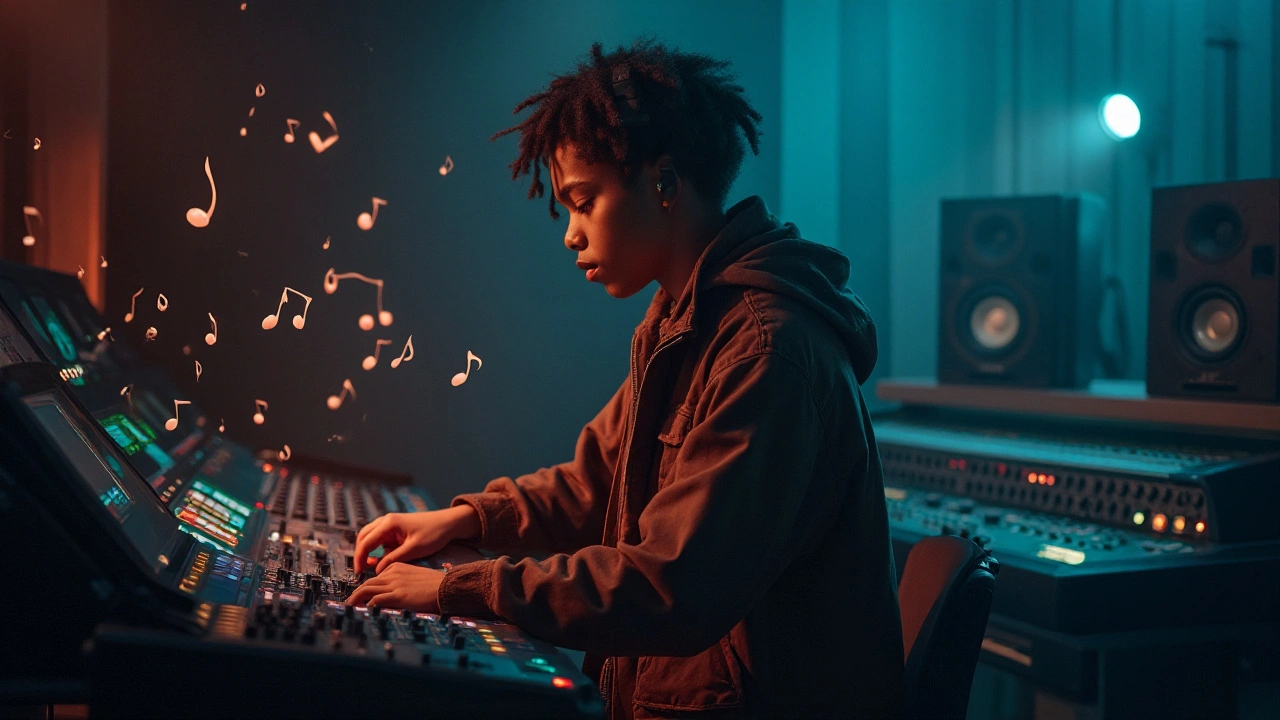Hip hop music has an almost magical ability to capture and hold the attention of listeners worldwide. Is it just the mesmerizing beats, or is there something more profound in play? This genre's infectious rhythms appeal to something deep within us, but what is it precisely that makes these tracks so addictive?
Though it might seem like magic, there's a potent mix of science and art at work. Research into the fields of music psychology and neurobiology reveals fascinating insights into how and why hip hop's rhythm impacts us the way it does. We'll explore the elements at play—from the anatomy of beats to the psychology of why we can't stop tapping our feet. Unravel how these components come together to create music that's as emotionally effective as it is pervasively appealing.
- The Allure of Beats
- Psychological Impact
- Rhythmic Patterns and Perception
- Elements of Enduring Appeal
The Allure of Beats
In the vast universe of music genres, hip hop stands out for its exceptional ability to hold listeners in a rhythm-infused trance. At the heart of this magnetic charm are the beats that drive hip hop's pulsating rhythms. These beats strike a primal chord, compelling us to move, dance, and nod along even before we consciously realize it. But why do these sequences have such a profound effect on us? Understanding this allure involves looking into the way our brain processes rhythm. The syncopated patterns in hip hop deliver a rhythmic surprise that our minds are eager to decode, leading to increased alertness and engagement. This compelling draw is not accidental—it’s a cleverly crafted auditory experience designed to capture attention.
Delving deeper, research highlights that the appeal of hip hop beats can partially be credited to the so-called 'syncopation sweet spot.' Work by neuroscientists suggests that these rhythmic irregularities challenge our brain just enough to keep it interested but not overwhelmed. It's the perfect balance between familiarity and surprise that keeps us coming back for more. According to a study by cognitive psychologist Dr. Aniruddh Patel, "Humans are hardwired to respond positively to beat-based music, and hip hop takes this connection to a whole new level." Such rhythms not only activate our auditory experiences but also engage motor regions in the brain, explaining why tapping a foot or bobbing a head becomes an involuntary response during a catchy hip hop track.
The seductive pull of hip hop's rhythm is underscored by the sensory feedback loop it establishes between the music and the listener's emotional state. As the beat progresses, it communicates urgency, energy, or relaxation, which in turn influences how we feel. This might explain why various tracks are suitable for distinct moods, from the adrenaline-pumping anthems played during workouts to the slow jams suitable for unwinding. The continuous exchange between beat and emotion forms the cornerstone of hip hop’s emotional resonance, transcending barriers of language and culture. Understanding the context in which these beats thrive gives us insights into why they resonate so profoundly.
Lyrically advanced or music-driven hip hop tracks rely on these beats to set the tone. They construct an auditory landscape that not only complements but amplifies the messages conveyed through lyrics. The symbiotic relationship between the strong percussive elements and other musical components—background instruments or samples from other genres—creates a richly layered sonic experience. This interplay showcases the dynamic and adaptable nature of hip hop, which can diversify into subgenres while keeping its rhythmic allure intact. For a genre born out of cultural reinvention and expression, the beats in hip hop continue to be a symbol of resilience and identity.

Psychological Impact
When you immerse yourself in the world of hip hop, the experience is as much physical as it is mental. The brain processes rhythm and melody in distinct ways, which explains why this genre taps into our psyche so effectively. The rhythmic patterns prevalent in hip hop music synchronize with our internal clocks, creating a strong urge to move in time with the beat. This synchronization isn't just physical; it extends to our emotional state as well.
The phenomenon of 'entrainment' plays a crucial role here. It's a process by which the body and mind attune themselves to an external rhythm, creating a unifying effect. Studies show that when we listen to music with consistent beats, our heart rate and brain wave patterns align with those beats, putting the body into a relaxed yet alert state. This serves to explain why certain hip hop tracks can be mood enhancers, capable of lifting spirits or providing energy.
A compelling aspect of hip hop's psychological sway is its lyrical content. Songs often narrate personal stories or societal issues, resonating with listeners on a deeper level. The raw emotions conveyed through rhymes can evoke empathy and understanding. As KRS-One, a foundational figure in the genre, eloquently put it, "Hip hop is the new Rock n Roll, it speaks to and for a generation of hopefuls." This highlights hip hop's ability to provide a voice and platform for otherwise marginalized perspectives, enabling a wider cultural and psychological impact.
Moreover, research suggests that our brain's reward systems light up when we listen to catchy rhythms, releasing dopamine, the feel-good neurotransmitter. This pleasurable association enhances the overall experience, explaining our recurring gravitation towards hip hop tracks. The predictability intertwined with slight rhythmic surprises keeps our brains entertained, leading to both enjoyment and a form of mental workout. It's this balance—alongside powerful lyrical messages—that shapes the unique identity and appeal of hip hop.
In an interesting study conducted by the University of Cambridge in 2022, researchers tried to quantify how strongly individuals reacted to different musical styles. They found that listeners of hip hop demonstrated a 40% higher retention of emotional and lyrical content compared to those listening to other genres. This remarkable finding underscores the genre's psychological depth, able to foster both cognitive and emotional responses that linger long after the music has stopped playing.

Rhythmic Patterns and Perception
Rhythm forms the backbone of hip hop music, and it's these meticulously crafted patterns that dictate how listeners interact with a track. To break down these rhythmic complexities, it's essential first to understand the role of tempo in shaping perception. Generally, hip hop music hovers around a tempo of 80 to 130 beats per minute (BPM). This tempo range is no accident; it's derived from the natural pace of human heartbeats during varying states of activity. Studies have shown that music with a tempo that aligns with a person's heartbeat during excitement can elevate their mood. Did you ever wonder why you instinctively nod your head or tap your foot? That's because rhythmic synchronization with a beat is a deeply ingrained response that music psychologists refer to as 'entrainment.' The brain aligns its neural oscillators with the external rhythmic pattern, creating a harmonious internal rhythm.
The use of specific rhythmic structures such as syncopation, where strong beats and weak beats are played off each other in unexpected combinations, is another reason why hip hop has a unique grip on listeners. Syncopation introduces an element of surprise and curiosity, piquing the brain's interest and maintaining a listener's engagement. A scientific study published in the Journal of New Music Research posits that syncopated rhythms stimulate higher cognitive processing. In essence, the brain is intrigued by unfamiliar patterns, leading to higher interest levels and emotional engagement. This is often why hip hop beats leave a lasting impression long after the music has stopped playing.
A key element behind this is the bassline. A well-crafted bassline can carry a track's emotional weight and is often responsible for that satisfying thump you feel resonating in your chest. Interestingly, low-frequency sounds tend to establish a sense of grounding and authority, which is why bass-heavy tracks are synonymous with power and energy. Neuroscientific findings emphasize that the human brain is exceptionally responsive to lower frequencies in musical compositions. According to a report in the Journal of Neuroscience, bass frequencies are processed by parts of the brain associated with movement and emotional arousal. This connection suggests why bass-laden tracks are perfect for dance and why they seem to make us feel alive and energized.
Let's turn to song structure as another significant factor that plays into the perception of rhythms. Hip hop artists often employ 'four-on-the-floor' beats, but with layers of percussion and electronic elements on top, creating something complex out of something simple. A balance of repetitive and varied sequences captures attention without overwhelming it. The pattern of verse and chorus in hip hop often mirrors a call and response format. This mimics natural conversational patterns, creating a sense of familiarity and connection for the listener.
"The idea of having a heartbeat-like pulse throughout a song is crucial in making music that feels lively and urgent," noted Dr. Claudius Conrad, a surgeon who also explores the intersections between music and human physiology. "It reminds us we are alive and makes us feel connected."
In recent years, technology has further expanded the horizons for rhythmic experimentation. Digital music production tools enable artists to deconstruct traditional rhythmic patterns and reassemble them in surprising, innovative ways. This artistic flexibility opens the door to infinite creative possibilities, ensuring that hip hop remains a vibrant and ever-evolving genre. Emphasis on diverse rhythmic experiences not only satisfies musical curiosity but also caters to a wide array of emotional and cultural contexts. As artists continue to push the boundaries, one thing remains clear: rhythmic patterns in hip hop do more than entertain; they offer a complex, interactive experience that resonates deeply with human perception.

Elements of Enduring Appeal
The hypnotic nature of hip hop music can be ascribed to several factors that keep listeners coming back for more. One of the key elements lies within the genre's rhythmic characteristics. These beats, often deeply layered and complex, tap into our brain's most intrinsic responses to sound patterns. The rhythm has been shown to trigger reactions in the brain's motor regions, which explains why our body wants to tap a foot or nod a head almost involuntarily when we hear a catchy hip hop track. Studies have indicated that rhythm processing can engage neurons capable of decoding beats, making them irresistible, thereby leaving an indelible mark on our psyche. This neurological overlap between beats and physical responses is part of what makes hip hop so enduringly captivating.
Another important factor is the lyrical content. Hip hop provides one of the most dynamic platforms for storytelling through music. The lyrics often tell personal narratives, community histories, or articulate social issues that resonate powerfully with listeners. This engaging storytelling acts as a mirror reflecting the lived experiences of many, making listeners feel heard and represented. A striking observation was made by musicologist Adam Krims, who noted that hip hop's lyrical narratives often resonate because of their authenticity and relatability. "The voice is the soul," he said, highlighting the raw, emotional connection listeners often feel. It’s this emotional depth that cements a strong bond between the music and its audience.
Moreover, hip hop's adaptability and continuous evolution plays a crucial role. As a genre born out of a need for expression and innovation, hip hop consistently incorporates new sounds, cultures, and technologies. It merges with countless other music genres, producing fusion genres that keep it fresh and exciting. This flexibility means hip hop can constantly reinvent itself, thus remaining relevant through varying cultural shifts. An example of this evolution can be seen in the incorporation of electronic sounds, which expanded the genre’s sonic palette and attracted diverse audiences.
There's an underestimated yet powerful element within hip hop—its community aspect. Hip hop isn’t just music; it’s a culture and a movement. The communities that foster hip hop vibe are deeply rooted in collaboration and shared experiences. Artists, producers, and fans form a cohesive unit, supporting each other's creativity and messages. This sense of belonging provides a deep connection that transforms casual listeners into lifelong devotees. It's this community-driven energy that injects lasting appeal into hip hop music.
To sum it up, the catchiness of hip hop is a complex concoction of rhythm, narrative, adaptability, and community. All these elements work in harmony to foster an enduring love for the genre, continually engaging and growing its audience. As hip hop continues to expand and adapt in the future, its fundamental components of rhythm and community are likely to remain the beating heart of its universal allure.

